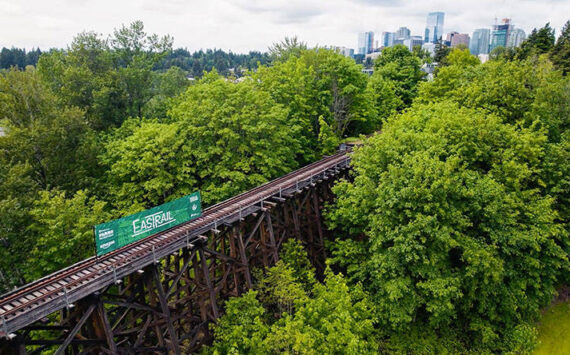The silver slug’s return to Seattle was met with wild enthusiasm and unbridled curiosity. But in the almost two years since the ferry Kalakala returned to Puget Sound, public interest has waned, donations have dried up, and efforts to generate income onboard the boat have run afoul of the Coast Guard and the Seattle Fire Department.
With costs to restore the ferry estimated at $10 million, Peter Bevis, the artist responsible for dragging the Kalakala out of the mud in Kodiak, Alaska, and shepherding it home, seriously considered relocating the boat to the Bay Area. Late last month, Bevis was contacted by a fledgling group that is trying to establish a monumental museum on San Francisco’s Treasure Island featuring half a dozen ferries, including the Kalakala.
Although Bevis toured the site and met with the project’s backers, he says discussions are “very preliminary” and the intent—for now—is to keep the Kalakala in Seattle.
However, hosting live shows and parties on the boat, one of the more promising strategies for keeping public interest alive while generating a little income, has run aground on a shoal of regulations. Bevis estimates it would cost hundreds of thousands of dollars just to get the ferry up to code and shipshape to house public events and tours.
Last October, Rod Hatfield, a Seattle promoter and events coordinator for the Kalakala Foundation, started holding multimedia fund-raisers on the Kalakala to cover the rent for the boat’s moorage and possibly do more.
The inaugural show was a Halloween benefit featuring a screening of Nosferatu with a live score performed by local musicians. It was the first time in three decades the Kalakala was open to the public. Organizers expected a few hundred people for this first show. Attendance hit 1,000.
“We were really, really encouraged by the response,” notes Hatfield. Following the success of the Halloween show, Hatfield began organizing shows every six weeks or so, using mostly fringe performance artists and musicians from the Seattle area.
Subsequent shows on the Kalakala, all of which were 21 and over, included a New Year’s Eve party, a screening of Bruce Lee’s Enter the Dragon, and an Earth Day event,and continued to bring in revenue, Hatfield says.
Through word of mouth these underground shows were almost becoming mainstream. But with greater visibility came setbacks that have resulted in a moratorium on fund-raising shows on the Kalakala.
“Once again, we are a victim of our own success,” comments Bevis.
The first signs of trouble surfaced in early April. For the first few shows, the Kalakala was under the jurisdiction of the Coast Guard. It was allowed to put on events the Coast Guard classifies as “private parties,” shows that operate with a suggested donation only, rather than advance ticket sales. Once events are advertised with a designated ticket price or tickets are sold, the event becomes “public” and the private party classification is violated, explains the Coast Guard’s Lt. Rebecca Harvey. Such a violation can result in the Coast Guard simply canceling the show or meting out stiff fines.
The Coast Guard does not want to be in the business of regulating floating performance spaces. When a promoter working with Hatfield sold some tickets in advance for an April show featuring jazz artist Karl Denson, the Coast Guard caught wind of the sales and recommended the Kalakala seek permanent moorage. If the Kalakala changed its status from that of a temporarily docked ship giving private parties to a permanently moored vessel putting on regular shows, the boat would be treated as a building and the responsibility for its regulation would shift from the Coast Guard to the city of Seattle.
Feeling the heat of the Coast Guard’s concerns, Hatfield canceled the jazz show but remained optimistic that live performances could still happen on the Kalakala. With this in mind, he went forward with plans to book a Fourth of July bash. While this was in the works, a local theater group approached Kalakala organizers wanting to house a six-week run of Chekhov’s The Seagull. Like the Denson show, The Seagull was promoted not as donation-only but as a ticket event, which once again caught the eye of the Coast Guard.
On the eve of a Fourth of July show expected to draw 500 people, Kalakala organizers were notified by the Coast Guard that they had now been designated a permanently moored vessel, Lt. Harvey said. That same day, the Seattle Fire Department showed up at the Kalakala to inspect. Following the inspection, the Fourth of July show was allowed to go on, but the Fire Department said no more than 200 people could attend. And after that night, “We told the Kalakala to put a hold on events until they get a certificate of occupancy, just as normal businesses do,” said Capt. Joel Andrus of the Fire Department’s Special Events Unit.
The Seattle Fire Department would not comment on the inspection specifically or its findings. But Kalakala organizers concede the boat requires significant repairs to meet the Fire Department’s codes. Without the necessary funds and benefit shows to generate money, it’s an uphill battle.
“The Fire Department would like to see a second exit. That was perhaps the biggest thing,” Bevis says. “I’m not arguing with the officials. I’d like to see the same things done.”
If the necessary work is done to get the Kalakala up to fire codes and they obtain a certificate of occupancy, Capt. Andrus says organizers will not have to reapply for permits every time they want to book an event.
Though the future of the Kalakala as a viable tourist attraction and performance art venue in Seattle is shaky and the Bay Area beckons, Hatfield is confident the Kalakala has more Puget Sound history to write. “Definitely, don’t count the Kalakala out,” he says.








